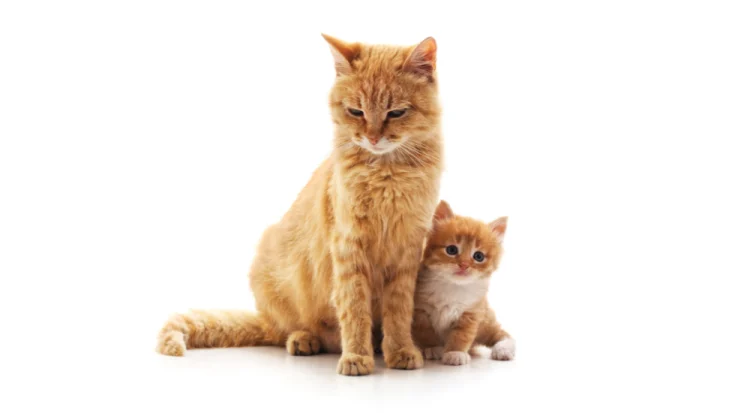“The Feline Growth Journey: Understanding When Cats Stop Growing”

The journey of a kitten evolving into a full-grown cat is a fascinating and adorable process. Cat lovers often find themselves eagerly awaiting the moment when their furry companions reach their adult size. However, understanding when cats stop growing involves more than just observing changes in size. This article delves into the intricate details of feline growth, exploring the factors that influence it and providing insights into the various stages of a cat’s development.
Stages of Feline Growth:
Cats undergo distinct developmental stages, each marked by specific physical and behavioral changes. The journey from a tiny, fragile kitten to a mature, independent cat typically encompasses several months. Understanding these stages can help cat owners appreciate and facilitate their pets’ growth.
Neonatal Stage (0-2 weeks): During the neonatal stage, kittens are entirely dependent on their mother for nourishment and warmth. They are born blind and deaf, relying on their sense of touch and smell to navigate the world. At this point, growth is rapid, with the kittens doubling their birth weight within the first week.
Transitional Stage (2-4 weeks): As kittens enter the transitional stage, their eyes begin to open, and they become more aware of their surroundings. They start to wobble around on unsteady legs and develop basic coordination. This period marks the beginning of the weaning process, as kittens gradually transition from mother’s milk to solid food.
Socialization Stage (4-12 weeks): The socialization stage is crucial for a kitten’s overall development. During this time, they learn vital social skills by interacting with their littermates and mother. Play becomes an essential part of their day, contributing to the development of coordination, hunting instincts, and social bonds. By the end of this stage, kittens are usually ready to be separated from their mother and introduced to their forever homes.
- Juvenile Stage (3-6 months): The juvenile stage is characterized by a significant growth spurt. Kittens begin to resemble miniature versions of adult cats, both in appearance and behavior. This is the time when their adult teeth start to emerge, and they become more independent. While growth is still noticeable, it may not be as rapid as in the earlier stages.
- Adolescent Stage (6 months – 2 years): The adolescent stage is when most cats experience the bulk of their growth. During this period, they reach their full skeletal size and start developing their adult coat. Sexual maturity also occurs during this time, with variations depending on the breed and individual factors.
Factors Influencing Growth:
Several factors contribute to a cat’s growth rate and ultimate size. These include genetics, nutrition, health, and environmental factors.
- Genetics: The genetic makeup of a cat plays a significant role in determining its size and growth rate. Different breeds have distinct growth patterns, with some reaching full maturity earlier than others. Mixed-breed cats may display a combination of traits from their diverse ancestry, making it challenging to predict their growth with precision.
- Nutrition: Proper nutrition is paramount for healthy growth in cats. Kittens require a diet rich in essential nutrients, including high-quality proteins, fats, vitamins, and minerals. Commercial kitten food is formulated to meet these specific needs during the early stages of life. As cats transition to adulthood, a balanced diet remains crucial to support their overall health and maintain an optimal weight.
- Health: The overall health of a cat directly impacts its growth. Illnesses or nutritional deficiencies can hinder proper development and result in stunted growth. Regular veterinary check-ups, vaccinations, and a well-balanced diet are essential components of ensuring a cat’s health and well-being.
- Environmental Factors: The environment in which a cat is raised can influence its growth and development. A stress-free, stimulating environment promotes positive mental and physical health. Adequate exercise and mental stimulation contribute to a cat’s overall well-being and can impact growth by preventing obesity and promoting muscle development.
Recognizing Maturity:
Determining when a cat has reached full maturity involves considering both physical and behavioral cues.
Physical Cues:
-
- Size and Weight: Cats typically reach their full size between 1 and 2 years of age, with some larger breeds taking a bit longer. However, individual cats may exhibit variations in their growth timelines.
- Reproductive Maturity: Sexual maturity is another indicator. Cats are capable of reproduction once they reach sexual maturity, which can occur as early as 4-6 months in some breeds.
Behavioral Cues:
- Playfulness: While cats remain playful throughout their lives, the intensity of play may diminish as they mature.
- Independence: Adult cats tend to be more independent than kittens, displaying a greater sense of autonomy.
Conclusion:
The journey of a cat from a tiny, helpless kitten to a fully grown, independent adult is a captivating process. Understanding the stages of feline growth, along with the factors influencing it, enables cat owners to provide the best care for their furry companions. Recognizing when a cat has reached maturity involves considering both physical and behavioral cues, allowing for a deeper connection between humans and their feline friends. As cats stop growing, they embark on a new chapter of their lives, bringing joy and companionship to those fortunate enough to share their homes with these enigmatic creatures.
When do cats stop growing?
A: Cats generally stop growing between 1 and 2 years of age. However, the exact timing can vary based on factors such as breed, genetics, and individual differences.
How can I tell if my cat has reached its full size?
A: Look for physical cues such as stable weight and size, as well as signs of reproductive maturity. Most cats reach their full size by 1-2 years, but larger breeds might take longer.
Are there specific signs that indicate my cat has stopped growing?
A: Yes, some signs include a stabilized weight, no noticeable increase in size, and the absence of physical changes associated with growth, such as the emergence of new adult teeth.
Do different cat breeds have different growth rates?
A: Yes, cat breeds vary in their growth rates. Larger breeds, like Maine Coons, may continue growing for a more extended period compared to smaller breeds, which often reach maturity sooner.
Can I predict my cat’s final size based on its kittenhood?
A: While genetics play a significant role, predicting a cat’s final size based solely on its appearance as a kitten can be challenging. Mixed-breed cats may display a combination of traits from their diverse ancestry.
Should I adjust my cat’s diet as it grows?
A: Yes, kittens require a specific diet with higher protein and nutrient content for proper growth. As they transition to adulthood, a balanced diet is essential to maintain their health and prevent obesity.
How important is genetics in determining a cat’s growth?
A: Genetics play a crucial role in a cat’s growth, influencing factors such as size, coat color, and overall appearance. Breeds have distinct growth patterns, so understanding your cat’s lineage can provide insights into its growth potential.
Can health issues affect a cat’s growth?
A: Yes, health issues, nutritional deficiencies, or illnesses can impact a cat’s growth. Regular veterinary check-ups, vaccinations, and a well-balanced diet are essential to ensure optimal health and proper development.
At what age do cats reach sexual maturity?
A: Cats can reach sexual maturity as early as 4-6 months, but this varies among breeds. Spaying or neutering is often recommended before this age to prevent unwanted behaviors and unplanned pregnancies.
Does the environment affect a cat’s growth?
A: Yes, the environment plays a role in a cat’s growth and overall well-being. A stress-free, stimulating environment with proper exercise and mental stimulation can positively impact growth by preventing obesity and promoting muscle development.
Will my cat’s behavior change once it reaches full maturity?
A: Yes, as cats mature, their behavior may change. They often become more independent, and the intensity of play may diminish. However, each cat is unique, and individual personalities can vary.
Can I influence my cat’s growth through its diet?
A: Providing a balanced and nutritious diet is crucial for a cat’s growth and overall health. While you can support proper development through diet, genetics will ultimately determine the cat’s final size.
Understanding when cats stop growing involves considering various factors, and monitoring both physical and behavioral cues can help cat owners gauge their feline companion’s developmental stage accurately. If there are concerns about a cat’s growth or health, consulting with a veterinarian is always recommended for personalized advice and care.






